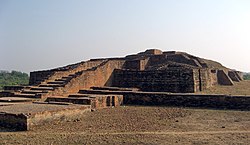Shravasti
| Shravasti | ||
|---|---|---|
|
|
||
| State : |
|
|
| State : | Uttar Pradesh | |
| District : | Shravasti | |
| Location : | 27 ° 31 ' N , 82 ° 3' E | |
| Height : | 110 m | |
| Residents : | 3,000 | |
| Shravasti - Anathapindika- stupa | ||
Shravasti (IAST: Śrāvastī ; Pali: Sāvatthī ) was an early Buddhist center in what is now the state of Uttar Pradesh in northern India . Today there is a town with about 3,000 inhabitants and a district of the same name with about 1.1 million inhabitants.
location
Today's place Shravasti is located in the northern Ganges plain about 2 km from the south bank of the Rapti and only about 10 km from the Nepalese border at an altitude of about 110 m . Most places of early Buddhism are about 150 km further east (e.g. Lumbini , Kapilavastu, etc.). Only about 2 km east of the village are the ruins of the former Jetavana monastery .
economy
The extremely fertile and agriculturally intensively used alluvial land of the Ganges plain sometimes offers two harvests a year. Small traders, craftsmen and various smaller service companies have settled in the village. Despite numerous pilgrims from all over Asia, tourism only plays a subordinate role in economic life.
history
Shravasti was around the middle of the 1st millennium BC. The capital of the small kingdom of Kosala and supposedly had well over 100,000 inhabitants. At that time there were already several Buddhist monasteries in the vicinity where the enlightened one ( Buddha ) stopped over 20 times on his extensive hikes through northern India and instructed the monks in his teaching. Most of the time he spent the annual rainy season ( monsoon ) here and the monks had enough leisure to learn his speeches by heart; in this way they laid the basis for the Nikayas of the Pali Canon . Later the city lost its importance , but not the fertile region of Avadh (English: Oudh ). In 1280 a subahdar of the Sultanate of Delhi is installed; the Mughals continued this tradition in the 16th and 17th centuries, from which the quasi-independent dynasty of the Nawabs of Oudh developed. From 1858 until India's independence (1947), the region officially belonged to British India .
Attractions
In the park of the former Jetavana monastery there are several ruins of monastery and stumps of votive stupas . There is also an old Bodhi tree here. A small square framed by walls marks the alleged location of the Buddha's hut (mulagandhakuti) . Several temple ponds were used to supply drinking water . On the edge of the Jetavala zone, several Asian Buddhist communities have built monasteries in the style of their countries. An approximately 25 m high gilded Buddha statue on a temple substructure towers above everything.







